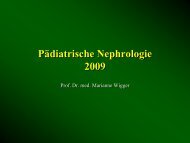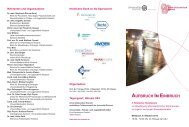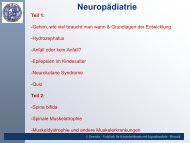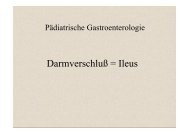Stable isotopes in gastroenterology and nutrition
Stable isotopes in gastroenterology and nutrition
Stable isotopes in gastroenterology and nutrition
- No tags were found...
You also want an ePaper? Increase the reach of your titles
YUMPU automatically turns print PDFs into web optimized ePapers that Google loves.
<strong>Stable</strong> Isotopes<strong>in</strong> Gastroenterology <strong>and</strong> NutritionKlaus D. Wutzke, Ph.D.,., D.Sc.Children‘s s Hospital of the University of RostockResearch Laboratorywww.k<strong>in</strong>derkl<strong>in</strong>ik-rostock.derostock.de ‘Forschung‘
In 1990 actually a dream became reality:<strong>Stable</strong> isotope research at Cornell University
Headl<strong>in</strong>esI would like to enterta<strong>in</strong> you with the follow<strong>in</strong>g items, namely:• <strong>Stable</strong> <strong>isotopes</strong>• Measur<strong>in</strong>g methods•13 CO 2 -Breath tests•13 C-Urea breath test for Helicobacter pylori diagnosis•13 C-Methacet<strong>in</strong> <strong>and</strong> 13 C 2 -am<strong>in</strong>opyr<strong>in</strong>e for liver function tests• Lactose-[ 13 C]ureide breath test for orocoecal transit timemeasurements• Impact of L-carnit<strong>in</strong>eLon fat oxidation• Utilisation of doubly labelled Lactobacillus johnsonii yoghurt.
<strong>Stable</strong> <strong>isotopes</strong>• They are rare.• „Isostopos“ (Greek) „on the same place“ at the periodicsystem of the elements.• Features, peculiarities:• Non radioactive.• Equal number of protons <strong>and</strong> electrons• identical chemical properties.• Different number of neutrons• different physical properties (mass).
<strong>Stable</strong> carbon isotope-612 C-6+-++ + +++(98,9%) 13 C (1,1%)6 -+--neutronsprotonselectronsresemble-7 6 6 ---++ + +++----Isotope (Greek : : same; : : place)
Isotope-man/wom<strong>and</strong>eliberately German suffix: … stoff1216.0 kg (23 %)13192.0 gA 70 kg-man conta<strong>in</strong>s314 gheavy stable <strong>isotopes</strong>.Stakeholders:2H, 13 C, 15 N, 17 O, 18 O1696.0 g 16181.82 kg(2.6 %)42.4 kg(61 %)1717.2 g7.00 kg(10 %)7.14 g12.10 gmodified from Wada
Basic requirements of the tracer technique• The application of a stable isotope labelled tracer substancenecessarily give rise to an <strong>in</strong>crease of the isotopic enrichment of theorganism.• The metabolic fate of the tracer can be followed by measur<strong>in</strong>g itsenrichment.• It is possible to draw conclusions for the respective unlabelledsubstance (biologically <strong>in</strong>dist<strong>in</strong>guishable from the tracee).
Measur<strong>in</strong>g methods• Analytical method• mass spectrometry( 2 H, 13 C, 15 N, 18 O)• CF-IRMS• CF-C-IRMS• nondispersive• <strong>in</strong>frared spectroscopy• nuclear magnetic resonancespectroscopy (NMR)• Accuracy [atom-%]• 0.01• 0.0001• 0.001
Equipment: Tracer Mass 20-20,20, SerCon, , Crewe, UK
Mass spectrometry on the <strong>in</strong>terstateRostock 50 kmResearch Laboratorycross w<strong>in</strong>d100 km/ hour1.8 t12C 18 O 16 O M=46Make an educated guess …1.2 t0.6 t13C 16 O 2 M=4512C 16 O 2 M=44speed: 100 km/ hourcrash barrier
FANci2, Fischer GmbH, Leipzig
13 CO 2 -Breath tests• Benefits, <strong>in</strong>centives:• Non <strong>in</strong>vasive• Non radioactive• On site, ad hoc• Sensitive, specific• Quick <strong>and</strong> simple
from G. Wagner
Helicobacter pylori diagnosis
Degradation pathwayIngestion of 75 mg[ 13 C]urea dissolved<strong>in</strong> 100 ml orangejuice after anovernight fast.from H. Fischer
Interpretation
13 C-Methacet<strong>in</strong> <strong>and</strong> 13 C 2 -am<strong>in</strong>opyr<strong>in</strong>e for liver function testsBasis of the [ 13 C]methacet<strong>in</strong> breath testH 3 CCONH13O CH 313CH3The microsomial dealcylation of[ 13 C]methacet<strong>in</strong> (paracetamol derivative)to p-hydroxyacetanilide is catalysed by thecytochrome P450 oxygenase system.The cleaved methyl group is oxidised toformic acid <strong>and</strong> is f<strong>in</strong>ally exhaled as 13 CO 2 .
Degradation pathway[ 13 C 2 ]Am<strong>in</strong>opyr<strong>in</strong>e is degraded bycytochrome P450 oxygenasemediated demethylation <strong>and</strong> oxidation toformaldehyde which is converted tobicarbonate <strong>and</strong> f<strong>in</strong>ally exhaled as 13 CO 2 .
CO 2 -exhalation without <strong>and</strong> after red w<strong>in</strong>e dr<strong>in</strong>k<strong>in</strong>g <strong>in</strong> healthy adults<strong>in</strong> strik<strong>in</strong>g comparison to subjects suffer<strong>in</strong>g from liver cirrhosis13 CO[%]50403020100[13C]methacet<strong>in</strong>[13C]am<strong>in</strong>opyr<strong>in</strong>ewithout with red w<strong>in</strong>e (10 days: 0.4 g ethanol/ kg) cirrhosis
The impact of L-carnit<strong>in</strong>eLsupplementation onfat oxidation <strong>and</strong> prote<strong>in</strong> turnoverL-carnit<strong>in</strong>e• Po<strong>in</strong>t out: The primary function of L-carnit<strong>in</strong>eLis to „shuttle“fatty acids <strong>in</strong>to the mitochondria where they can be brokendown by -oxidation.
Chemical structure of L-carnit<strong>in</strong>eLH 3 CH 3 C–N + – CH 2 – CH – CH 2 – COO -H 3 COH
Aim of the studyEvaluation of the metabolic effect of L-carnit<strong>in</strong>eLsupplementation on• whole-body prote<strong>in</strong> turnover• [ 15 N]glyc<strong>in</strong>e, three-compartment model along with• fat oxidation• [U- 13 C]algae lipid mixture,• <strong>in</strong> slightly obese subjects.
Composition of 13 C-algae fatty acid mixture“Comparatively representative for fatty acid metabolism”[%]505040302720109130palmitic acidC16:0oleic acidC18:1palmitoleicacid C16:1l<strong>in</strong>oleic acidC18:2
ResultsCO 2 -enrichmet13 CODOB141210864200 2 4 6 8 10 12 14time [hours]without with L-carnit<strong>in</strong>e
Cumulative 13 CO 2 -exhalation25201519,3 %15,8 %[%]10500 2 4 6 8 10 12 14time [hours]without with 3 g/day L-carnit<strong>in</strong>e
Prote<strong>in</strong> turnover rates[g/kg/day]43,532,521,510,503,72 3,65synthesis3,41 3,41breakdownwithoutwith L-carnit<strong>in</strong>e
Interpretation, conclusion• Anyway, it turned out that L-carnit<strong>in</strong>eLseem<strong>in</strong>gly <strong>in</strong>creased thefat oxidation <strong>in</strong> slightly obese subjects, whereas prote<strong>in</strong>turnover rema<strong>in</strong>s unchanged.
Glycosyl-[ 13 C]ureides for measur<strong>in</strong>g theorocoecal transit time[ 13C]-Sugarureides13 C]• Address: No enzymatic degradation of the sugar-urea urea bond <strong>in</strong>the small <strong>in</strong>test<strong>in</strong>e alleged.• Clostridium <strong>in</strong>nocuum is accounted for the exclusivedegradation.• Ubiquitous present <strong>in</strong> the coecum (Mohr, BBA;1998).• Launched <strong>in</strong> 1993 by He<strong>in</strong>e, AJG.• Experienced with own laboratory synthesis: Lactose-[ 13 C]ureide: : marker for measur<strong>in</strong>g orocoecal transit time(OCTT). Credit: Wutzke, EJCN;1997, 2004, 2010.
Lactose-[ 1313 C, 1515 N 2 ]ureide (DLLU)CH 2 OHOCH 2 OHOO13CHOHHH15NH15NH 2galactoseOglucoseHOHHHOHHHHOHHOH
Gradual degradation of lactose-[ 13lactose-[ 13 C, 15 N 2 ]ureide13 C, 1515 N 2 ]ureideß-galactosidasesmall bowelgalactose +glucose-[ 13 C, 15 N 2 ]ureideglucose ureide hydrolaseClostridium <strong>in</strong>nocuumcoecumglucose + [ 13 C, 15 N 2 ]ureaurease: Klebsiella, Bacteroidescolon13CO 2 + 2 15 NH 3lungkidney13C, 15 N-measurementIRMS
Measurement of the orocoecal transit time with lactose-[ 13 C]ureide8765DOB432cut-off: > 2 DOB100 1 2 3 4 5 6 7 8 9 10 11 12 13 14 1513C-LUOCTT time [h]13C-LU
Utilisation of doubly stable isotope labelled Lactobacillusjohnsonii yoghurt <strong>in</strong> humans• In the face of Lactobacillus johnsonii (La1), a probioticlactobacillus stra<strong>in</strong> of human orig<strong>in</strong>, is evidently able to adhereto the <strong>in</strong>test<strong>in</strong>al mucosa.• One of the important properties of probiotics is the ability tosurvive the dangerous journey through the <strong>in</strong>test<strong>in</strong>e.• For evaluation of this issue (phenomenon), La1 was used fordoubly labell<strong>in</strong>g with 15 N <strong>and</strong> 13 C to follow the metabolic fate oforally adm<strong>in</strong>istrated doubly stable isotope 13 C-, 15 N-labelled La1<strong>in</strong> humans.
Aim of the study• Investigation of the metabolic fate of doubly 13 C-, 15 N-labelledLactobacillus johnsonii• the 13 CO 2 -exhalation,• the ur<strong>in</strong>ary <strong>and</strong> faecal 13 C- <strong>and</strong> 15 N-excretion, respectively,• <strong>and</strong> the correspond<strong>in</strong>g isotopic enrichment of specific bloodplasma fractions.
Material <strong>and</strong> methods• Universal labell<strong>in</strong>g of La1 with 13 C <strong>and</strong> 15 N• by fermentation (Biostad(Biostad, , Braun, Melsungen, , Germany) <strong>in</strong> amedium conta<strong>in</strong><strong>in</strong>g• [U- 15 N]yeast extract (prior labelled by [ 15 N]H 4 Cl) ) <strong>and</strong>• [U- 13 C 6 ]glucose (CamproScientific, Berl<strong>in</strong>)
Fermenter Biostad, , B. Braun, Melsungen
13 CO 2 -Enrichment <strong>and</strong> cumulative percentage exhalation8[DOB][%]1068644220OCTT0 2 4 6 8 10 12 14time [h]Keep an eye on it![DOB] [%]0
Ur<strong>in</strong>ary total <strong>and</strong> ammonia 15 N-enrichment0,35[at%exc]0,30,250,20,150,10,050OCTT0 6 12 18 24 30 36 42 48time [h]total-15N 15NH3
Isotope <strong>in</strong>corporation <strong>in</strong> different fractions of the blood0,20,18[at%exc]15N13C0,160,140,120,10,080,060,040,020supernatant fibr<strong>in</strong>ogen plasma prote<strong>in</strong>precipitate
Percentage total 15 N-excretion <strong>and</strong> 15 N-<strong>in</strong>corporation50.012.437.6renal faecal <strong>in</strong>corporation
Percentage total 13 C-excretion <strong>and</strong> 13 C-<strong>in</strong>corporation8.61.350.239.9expiratory renal faecal <strong>in</strong>corporation













